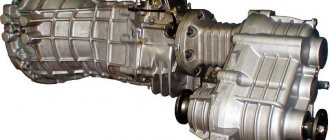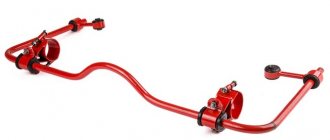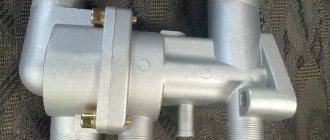Skidding is the most dangerous situation on the road. It is this that most often becomes the cause of driving into the oncoming lane and a head-on collision. Therefore, every driver must be able to properly deal with skidding. And we will describe in detail how to do this below.
It is worth warning in advance that the article is very voluminous and contains a lot of video materials on the topic. Therefore, we recommend that you arm yourself with a mug of coffee or tea, get comfortable, and carefully study the information presented below.
Sharp braking
If, when driving in rain or snow, the driver applies sharp braking, then, even despite the presence of ABS, the wheels lose traction with the slippery road surface. This provokes the drift of the rear axle of the car.
When braking sharply, a skid can occur even on a dry road. Therefore, such action is allowed only in extreme cases. Unnecessarily, resorting to sudden braking (and especially in rain or winter) is prohibited.
Taking a turn at high speed
Any experienced driver knows that before turning, you must slow down. Moreover, it does not depend on whether it is icy, wet or dry. Entering a corner at high speed is the most common cause of skidding. Most often, such a skid ends with driving into the oncoming lane or driving into a ditch.
Reducing speed when turning minimizes the risk of skidding. You must also remember that you should not resort to sudden braking when turning. When it rains or is icy, the speed should be reduced to 10-15 km/h less than on a dry road.
Traction distribution schemes for all wheels
This type of transport has the following advantages:
- the most efficient acceleration dynamics in terms of speed characteristics and gasoline consumption;
- the ability to easily overcome serious obstacles that are impassable for other types of transport;
- good grip when climbing on icy road surfaces.
But still, all-wheel drive does not always behave well in a skid. It's better to use a persistent layout. A compromise option is the ability to manually control the transmission. When the drive is connected automatically, if it starts to slide, this can lead to an even greater skid and even overturning of the vehicle. So pilots of such cars should be as careful as possible.
Is it possible to feel in advance that the car has gone into a skid?
It is quite simple to provoke a skid - just a sudden movement of the steering wheel or pressing the brake pedal. But not everyone is able to feel it at the initial stage. Especially if it concerns a person who has just received a driver’s license.
The feeling of skidding comes only with experience. Driving the same car for a long time, the driver begins to feel its dimensions and predicts the car’s behavior in advance. Even a slight skid begins to be clearly felt. And the driver takes measures in advance to correct the situation and take everything under control.
You can feel the skid in advance. But, as mentioned earlier, such instinct comes with time and driving experience. Moreover, for this the driver must sit correctly behind the wheel. We discussed the correct fit in detail in this article (we recommend reading it).
Rear axle demolition
Rear axle drift, or oversteer, is manifested in the loss of traction with the road surface of the rear wheels of the car. The car begins to “carry” sideways along the road. This is the most common and familiar type of skid to many drivers.
In such a situation, the driver needs to take his feet off the gas and brake pedals and turn the steering wheel in the direction of the skid. If the car is front-wheel drive, then, on the contrary, you need to carefully apply the gas.
Such a skid most often occurs due to the fact that the main weight of the car is shifted to the front axle, while the rear axle is unloaded. Accordingly, the rear wheels have less traction. This happens mainly during sudden braking.
Skidding of front-wheel drive cars
When a front-wheel drive car skids when turning, it is worth considering the design feature.
Here the front wheels should pull the car, so you need to press on the gas, promoting an increase in speed. In this case, the driver must ensure that the front wheels do not spin.
Steps requiring attention:
- Without stopping to press on the gas, it is necessary to align the wheels in the front.
- Timely action when a car skids is extremely important. Therefore, a moment before the stern is returned to its original position, the rudder turns in the opposite direction.
- The steering wheel returns to its original position before the rear end stabilizes.
When the danger has passed, the speed decreases and normal movement continues.
Front axle demolition
Front axle drift, or understeer, is the loss of traction on the vehicle's front wheels. In such a situation, the car simply does not “fit” into the turn and “flies” into a ditch or onto the sidewalk. Such a skid is very dangerous, since there may be pedestrians on the sidewalk who will not have time to quickly react to the danger.
Front axle drift occurs when the driver enters a turn at high speed. In such a situation, there is no need to try to turn the steering wheel even more, press the brake or add more gas. The pedals must be released (especially on rear-wheel drive or all-wheel drive vehicles).
How professionals behave when skidding in a car
How to distinguish a professional driver from a beginner?
A professional will choose the right one when starting to move. Then will be used on the steering wheel. When critical situations arise, a professional always uses the type of braking that is most effective for a given drive.
A professional differs from a beginner in that when turning, turning or any other maneuver, he can calculate and, if necessary, reduce the excess speed of his car. Thus, it will eliminate the chance of the car getting into a skid.
Firstly, they keep their cool, using the accelerator pedal correctly and using the steering wheel to bring the car out of a skid. This is evidenced by numerous auto racing competitions. Secondly, a true professional will make every effort not to get into a skid state. Now let's see how beginners behave when skidding in a car. Turning the steering wheel all the way, frantically pressing the brake pedal, closing your eyes, waiting in horror for the car to stop. Nowadays, learning to act correctly is not difficult. You can gain experience in one or another course under the guidance of a competent instructor. The knowledge gained will not be superfluous, but it is better that you use this knowledge as little as possible.
An uncontrolled skid is the worst thing that can happen on the road, especially to a new driver. At the same time, the car drives as it pleases, and the driver can only rely on luck and the absence of deep shoulders and oncoming cars on the road. In this article we will tell you what to do if your car skids and what actions are necessary.
So, what can cause a skid on a slippery road?
We have already talked about braking, but it is especially dangerous to brake while turning! Remember, the speed is reduced before entering the turn and preferably without changing gears, that is, without squeezing the clutch. Braking, changing gears, or accelerating too much when turning is dangerous. Sharp “shifts” of the steering wheel can also “loose” the car.
Modern electronic active safety systems, such as ABS, EBA, ESP, are very good helpers, in the event of loss of wheel traction, they independently regulate braking and torque on the wheels, but they will not be able to keep the car on the desired trajectory if the driver’s actions are inconsistent within reasonable limits.
By the way, if these systems work while driving (the corresponding symbols on the panel light up), then this is evidence that you have chosen the wrong speed and driving style. For a good driver, these systems only work in exceptional cases and very, very rarely. But just recently there were no such assistants, and nothing - they went. Therefore, let's talk about how to drive a car on a slippery road without electronics, even if you have one.
A few rules on how to avoid skidding on winter roads
If you start skidding, don’t brake.
This will not help, but will worsen the situation. It is very difficult not to do this - an unknown force puts your foot on the brake pedal, but you need to resist so as not to lose your last chance.
If the car starts to skid, do not press the clutch pedal either.
At this time, such an action is as useless as pressing the cigarette lighter button. Don't let off the gas pedal while skidding. If you smoothly release the gas on a rear-wheel drive car, and slightly increase it on a front-wheel drive car, you can reduce the skidding and level the car on the road.
Always turn the steering wheel in the direction of the skid. The back of the car goes to the left - turn the steering wheel that way, to the right - turn to the right.
This needs to be brought to automaticity, performed quickly and without jerking. You need to turn the steering wheel in the direction of skidding moderately.
Try to keep the front steering wheels in the desired direction of travel at all times. To do this, train yourself not to grab the steering wheel very often when turning, as most women do. Even in tight turns, try to keep either your right hand (in a left turn) or your left hand (in a right turn) on the steering wheel at all times - this will help you constantly feel the position of the wheels. Excessive turning of the steering wheel will not smooth out the skid, but will only intensify it.
In practice, drivers do not use controlled skidding very often. There are several reasons for this current situation. Firstly, this is the difficulty of performing this maneuver by a vehicle. Secondly, low in its execution. But, all the same, in difficult weather conditions it is sometimes useful to resort to its help.
Wheel lock
Wheel locking occurs when the driver sharply presses the brake pedal. At high speeds, the wheels stop rotating, and the car, by inertia (under its own weight), continues to move (slides along the road surface). This also causes skidding.
The actions in this case are simple - release the brake pedal so that the wheels resume rotation and traction returns. After which you can try to brake again, but pressing the brake smoothly and without sudden movements of the steering wheel.
Subscribe to our Telegram channel
Front-wheel drive drift
There is an opinion that only professionals and experienced drivers can perform front-wheel drive drifting, having previously prepared the car in a special way. It is quite difficult to put a front-wheel drive car into a controlled skid, but in practice there are several techniques that allow you to perform such a trick. Here you need to understand nature, master the drift technique, and you will have to practice more than once. If you, despite certain difficulties, have decided to put a car with front-wheel drive into a controlled drift, then read the lessons on drifting on front-wheel drive.
Drifting is a dangerous, but spectacular and useful maneuver, indicating the high skill of the driver
Why is drifting on front-wheel drive difficult?
Drifting is considered the signature trick of rear-wheel drive cars. The front wheels on this type of car only set the direction. In front-wheel drive cars, their functionality is expanded; they not only set the course of movement (steering), but also act as traction (propulsion), which provides the car with good stability, so it is quite difficult to put such a car into a controlled drift.
Watch the video that explains all the commandments of proper drifting.
Nature of drift
To ensure that drift lessons are not in vain, you should understand the nature of drift. Basically, skidding occurs when the wheels lose traction and the orientation of the rear wheels relative to the front wheels changes. To successfully drift in a front-wheel drive car, it is necessary to minimize the grip of the rear wheels and improve the grip of the front wheels.
It is much more difficult to keep a front-wheel drive car from skidding than a car with rear-wheel drive. It is necessary to adapt to the speed of the rear wheels, adjusting the trajectory of the front wheels using the gas and steering wheel. If the car is not prepared, then drifting on asphalt will be short-term, since almost immediately the rear wheels will grab the road; winter drifting is much easier to do. Next, be sure to watch the video on how not to drift, and what the consequences of unsuccessful maneuvers are.
Front-wheel drive drifting - training
A controlled skid is a kind of aerobatics, indicating the high professionalism of the driver. To successfully drift in a front-wheel drive car, theoretical lessons must be reinforced with practical skills, honing the skill and precision of movements on a special platform.
Drift at 180
A controlled 180° skid is considered the simplest exercise; it is quite easy to perform even on a front-wheel drive car. If your car has a stabilizing system, it must be turned off, otherwise all attempts are useless.
- Accelerate the car to a speed of 40-60 km/h, depress the clutch (this action is not performed on a rear-wheel drive car), sharply turn the steering wheel and pull the handbrake without removing your finger from the button, the car will turn around. After a second, return the handbrake to the lower position and press the brake to stop the car. The method only works at low speed.
- Enter the turn in a low gear, without releasing the gas, press the brake pedal sharply, but not too hard. Since the front pads are driven by the engine, with this action they are not able to stop the front wheels, but the rear ones will immediately block, and the car will skid.
- Enter a turn at high speed, the front axle may drift slightly. Reduce the gas sharply, by performing engine braking, you will load the front-wheel drive, the nose will dive into the turn, and the rear wheels will slide outward at this moment.
Do the 180° drift lesson several times to get a feel for how the car handles.
How to perform a controlled 90° skid on front-wheel drive
Drifting at 90 degrees with front-wheel drive is much more difficult. If during a controlled skid at 180° there is practically no need to control the car, then in this case you will have to monitor the angle of rotation of the wheels.
To perform the exercise, you should accelerate and before turning, turn the steering wheel in the direction you plan to turn, and sharply tighten the handbrake. To prevent the car from turning 180° again, it is important here:
- adjust the angle of rotation of the wheels;
- return the handbrake to the down position in time.
The success of a controlled drift largely depends on the speed with which the car enters the turn. After the handbrake is released, you must immediately change gear to a lower one, press the clutch and drive straight ahead. This trick is quite difficult, you usually have to practice for many hours in a row.
Controlled drift at 360°
Drifting on a front-wheel drive with a 360° turn is unlikely to be useful in real life; it is used more for beauty, to demonstrate a high level of driving skill. It is possible to perform a controlled 360° drift only on a car with a powerful engine, or there must be a gearbox with a locking function. Let's do the exercise:
- accelerate the car to 80 km/h;
- before the maneuver, depress the clutch without releasing the gas pedal;
- shift to a lower gear;
- turn the steering wheel sharply;
- apply the handbrake, keep your finger on the button;
- the car will turn around when the angle is 180°, lower the handbrake, clutch and sharply press the gas.
Using the gas, steering wheel and clutch, steer the car in a circle. Drifting at 360° looks impressive, having mastered the technique of such a turn, you will amaze the amazed audience with your skill.
Features of drifting with front-wheel drive - on asphalt
It was mentioned above that due to the specifics of front-wheel drive, it is very problematic to perform a controlled drift on an asphalt road surface, so in most cases, successful drifting in winter on front-wheel drive is possible.











